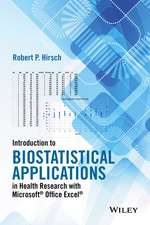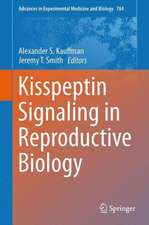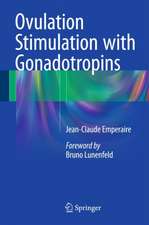Proteins: Membrane Binding and Pore Formation: Advances in Experimental Medicine and Biology, cartea 677
Editat de Gregor Anderluh, Jeremy H. Lakeyen Limba Engleză Hardback – 21 mai 2010
| Toate formatele și edițiile | Preț | Express |
|---|---|---|
| Paperback (1) | 1406.95 lei 6-8 săpt. | |
| Springer – 23 aug 2016 | 1406.95 lei 6-8 săpt. | |
| Hardback (1) | 1411.17 lei 3-5 săpt. | |
| Springer – 21 mai 2010 | 1411.17 lei 3-5 săpt. |
Din seria Advances in Experimental Medicine and Biology
- 9%
 Preț: 719.60 lei
Preț: 719.60 lei - 20%
 Preț: 691.93 lei
Preț: 691.93 lei - 5%
 Preț: 717.00 lei
Preț: 717.00 lei - 5%
 Preț: 716.28 lei
Preț: 716.28 lei - 5%
 Preț: 717.20 lei
Preț: 717.20 lei - 15%
 Preț: 640.24 lei
Preț: 640.24 lei - 5%
 Preț: 1113.83 lei
Preț: 1113.83 lei - 5%
 Preț: 715.71 lei
Preț: 715.71 lei - 5%
 Preț: 820.43 lei
Preț: 820.43 lei - 15%
 Preț: 641.38 lei
Preț: 641.38 lei - 5%
 Preț: 716.28 lei
Preț: 716.28 lei - 5%
 Preț: 523.99 lei
Preț: 523.99 lei - 5%
 Preț: 1031.00 lei
Preț: 1031.00 lei - 5%
 Preț: 717.00 lei
Preț: 717.00 lei - 5%
 Preț: 715.35 lei
Preț: 715.35 lei - 20%
 Preț: 1161.71 lei
Preț: 1161.71 lei - 5%
 Preț: 1170.51 lei
Preț: 1170.51 lei - 18%
 Preț: 1119.87 lei
Preț: 1119.87 lei - 5%
 Preț: 1288.48 lei
Preț: 1288.48 lei - 5%
 Preț: 1164.67 lei
Preț: 1164.67 lei - 5%
 Preț: 1101.73 lei
Preț: 1101.73 lei - 18%
 Preț: 1123.67 lei
Preț: 1123.67 lei - 5%
 Preț: 1435.64 lei
Preț: 1435.64 lei - 20%
 Preț: 1044.10 lei
Preț: 1044.10 lei - 18%
 Preț: 946.39 lei
Preț: 946.39 lei - 5%
 Preț: 292.57 lei
Preț: 292.57 lei - 18%
 Preț: 957.62 lei
Preț: 957.62 lei - 18%
 Preț: 1235.76 lei
Preț: 1235.76 lei - 5%
 Preț: 1231.55 lei
Preț: 1231.55 lei - 5%
 Preț: 1292.30 lei
Preț: 1292.30 lei - 5%
 Preț: 1102.10 lei
Preț: 1102.10 lei - 18%
 Preț: 1132.81 lei
Preț: 1132.81 lei - 5%
 Preț: 1165.19 lei
Preț: 1165.19 lei - 5%
 Preț: 1418.48 lei
Preț: 1418.48 lei - 5%
 Preț: 1305.63 lei
Preț: 1305.63 lei - 18%
 Preț: 1417.72 lei
Preț: 1417.72 lei - 18%
 Preț: 1412.99 lei
Preț: 1412.99 lei - 24%
 Preț: 806.16 lei
Preț: 806.16 lei - 18%
 Preț: 1243.29 lei
Preț: 1243.29 lei - 5%
 Preț: 1429.44 lei
Preț: 1429.44 lei - 5%
 Preț: 1618.70 lei
Preț: 1618.70 lei - 5%
 Preț: 1305.12 lei
Preț: 1305.12 lei - 18%
 Preț: 1124.92 lei
Preț: 1124.92 lei - 5%
 Preț: 1097.54 lei
Preț: 1097.54 lei - 15%
 Preț: 649.87 lei
Preț: 649.87 lei - 5%
 Preț: 1097.54 lei
Preț: 1097.54 lei - 18%
 Preț: 945.79 lei
Preț: 945.79 lei - 5%
 Preț: 1123.16 lei
Preț: 1123.16 lei
Preț: 1411.17 lei
Preț vechi: 1485.45 lei
-5% Nou
Puncte Express: 2117
Preț estimativ în valută:
270.11€ • 293.50$ • 227.04£
270.11€ • 293.50$ • 227.04£
Carte disponibilă
Livrare economică 31 martie-14 aprilie
Preluare comenzi: 021 569.72.76
Specificații
ISBN-13: 9781441963260
ISBN-10: 144196326X
Pagini: 168
Ilustrații: XXIV, 172 p.
Greutate: 0.45 kg
Ediția:2010
Editura: Springer
Colecția Springer
Seria Advances in Experimental Medicine and Biology
Locul publicării:New York, NY, United States
ISBN-10: 144196326X
Pagini: 168
Ilustrații: XXIV, 172 p.
Greutate: 0.45 kg
Ediția:2010
Editura: Springer
Colecția Springer
Seria Advances in Experimental Medicine and Biology
Locul publicării:New York, NY, United States
Public țintă
ResearchCuprins
Energetics of Peptide and Protein Binding to Lipid Membranes.- Membrane Association and Pore Formation by Alpha-Helical Peptides.- Role of Membrane Lipids for the Activity of Pore Forming Peptides and Proteins.- Cholesterol-Dependent Cytolysins.- Laetiporus sulphureus Lectin and Aerolysin Protein Family.- Interfacial Interactions of Pore-Forming Colicins.- Permeabilization of the Outer Mitochondrial Membrane by Bcl-2 Proteins.- Molecular Mechanism of Sphingomyelin-Specific Membrane Binding and Pore Formation by Actinoporins.- Hemolysin E (HlyE, ClyA, SheA) and Related Toxins.- Pore formation by Cry toxins.- Role of Heparan Sulfates and Glycosphingolipids in the Pore Formation of Basic Polypeptides of Cobra Cardiotoxin.- Amyloid Peptide Pores and the Beta Sheet Conformation.
Notă biografică
Gregor Anderluh is Associate Professor of Biochemistry at the Department of Biology, Biotechnical Faculty, University of Ljubljana, Ljubljana,Slovenia. He and his coworkers are studying protein-membrane interactions and how cellular membranes are damaged by proteins. He is a director of the InfrastucturalCentre for Surface Plasmon Resonance at the University of Ljubljana, where they study molecular interactions and are developing novel approaches on how to study protein binding to membranes. He received his PhD in Biology from University of Ljubljana and did his Postdoctoral at University of Newcastle, United Kingdom.Jeremy Lakey is Professor of Structural Biochemistry at the Institute for Cell and Molecular Biosciences, University of Newcastle, UK and runs an academic research group based loosely on the theme of protein biophysical chemistry with interests in protein toxins, membranes and bionanotechnology. Following a first degree in Zoology, Jeremy completed a PhD in Membrane Biophysics at the University of East Anglia UK, followed by periods at the Centre de Biophysique Moléculaire, Orléans, France; EMBL, Heidelberg, Germany and the EPFL , Lausanne Switzerland. He is currently an editor of the Biochemical Journal and member of the facility access panel for the ISIS pulsed neutron source, UK.
Caracteristici
Novel structures and biophysical studies on proteins Includes a comparison of the properties of membrane channels formed by amyloid proteins and pore forming toxins Gives comprehensive overview of what we know about proteins and highlights their general structural properties











